
Wind turbines usually consist of one turbine with a set of blades, but Norway’s Wind Catching Systems thinks its floating multi-turbine offshore wind technology will make clean energy more efficiently.
Floating multi-turbine offshore wind
The 320-meter-tall (1,050-foot-high) unit – that’s just 33 feet shorter than the Eiffel Tower – is made up of a matrix of beams that supports around 115 turbines. Each turbine has a diameter of around 30 meters (98 feet). The pilot project will be installed at Norway’s Mehuken wind park, on the west coast, this year.
Wind Catching Systems asserts that its floating technology can generate five times the annual energy of the world’s largest single turbines because it has double the swept area of a conventional 15 megawatt wind turbine. The company also says that its huge floating wind turbine unit could be used to power as many as 80,000 homes.
ENOVA, a government-owned company that works to promote renewable energy and energy efficiency in Norway, thinks Wind Catching Systems is onto something, as it just this week awarded the company a pre-project grant of NOK 9.3 million (US $0.9 million). This is the second grant that ENOVA has awarded Wind Catching Systems – the first was in October 2022 for NOK 22 million (US $2.1 million).
Wind Catching Systems was founded in 2017 and is headquartered at Lysaker, outside Oslo. The company’s largest owners are GM Ventures (the venture capital arm of General Motors), Ferd (Norway’s largest private investment company), and North Energy ASA, a publicly traded energy investment company listed on the Oslo Stock Exchange.
Electrek’s Take
This is certainly a creative and intriguing clean energy project.
The idea is that the smaller turbines will be more efficient and maximize power generation from a concentrated area and, due to their smaller size, could also handle higher winds. But will the small turbines have to rotate a lot faster to capture the same amount of power as larger, individual turbines? And might the giant matrix add a lot of extra drag?
Top comment by Aaarrrgggh
While my gut reaction was skepticism, being able to easily accommodate the wind shear and increasing RPM with constant tip speeds gives you a lot of opportunity. I can't imagine the bottom half of the array is doing much in terms of relative production, but maybe it gives them an option to optimize the blades and rotor diameter with height. Much more information is really needed to make a critical analysis.
We’ll keep an eye on how this pilot performs when it’s up and running. Let us know what you think in the comments below.
Read more: A Danish wind turbine giant just discovered how to recycle all blades
Photo: Wind Catching Systems
UnderstandSolar is a free service that links you to top-rated solar installers in your region for personalized solar estimates. Tesla now offers price matching, so it’s important to shop for the best quotes. Click here to learn more and get your quotes. — *ad.
FTC: We use income earning auto affiliate links. More.





Comments